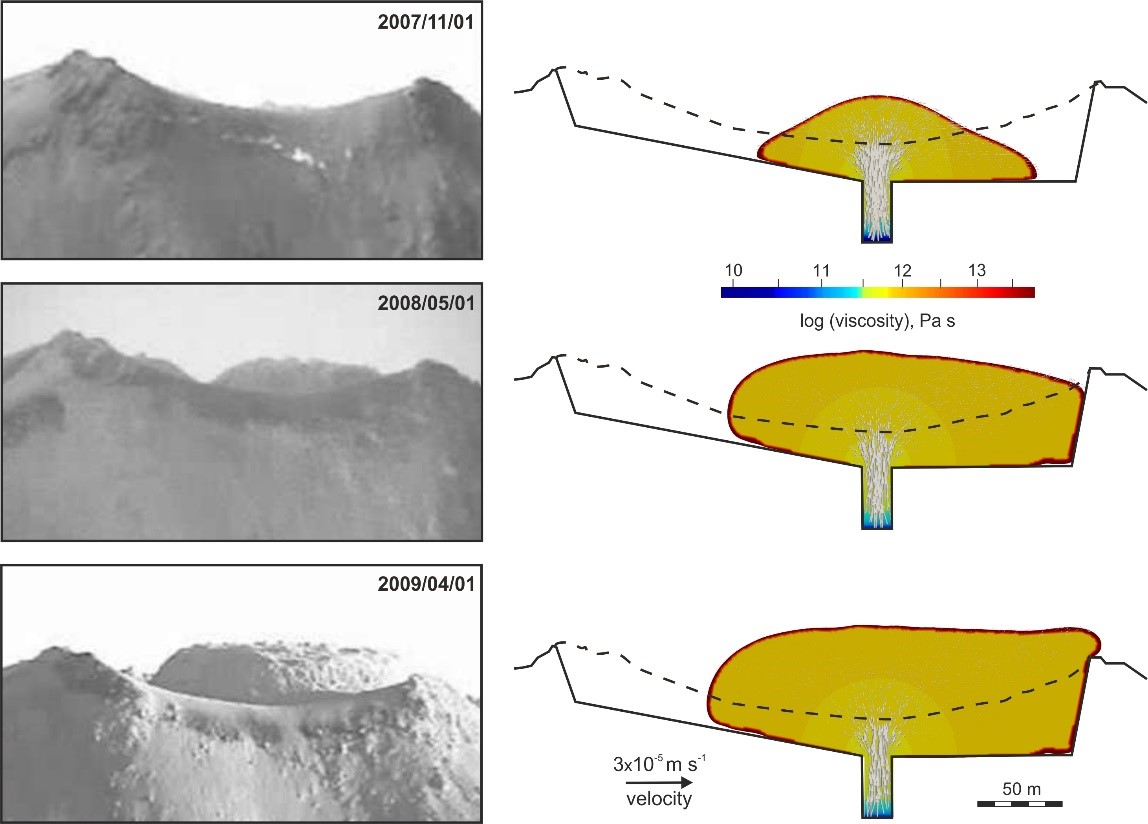Data-driven thermomechanical modelling of lava flows
- Ansprechperson:
A. Ismail-Zadeh
- Förderung:
Deutsche Forschungsgemeinschaft (DFG)
- Projektbeteiligte:
O. Melnik (Lomonosov Moscow State University, Moscow, Russia)
A. Korotkii (Russian Academy of Sciences, Yekaterinburg, Russia),
supported by the Russian Foundation for Basic Research (RFBR) - Starttermin:
2020
- Endtermin:
2023
This project addresses the evolution of lava flows by utilization of scientific knowledge in understanding of rheological behavior of lavas and integration of observations/measurements on temperature, heat flow, and displacement at the lava surface into quantitative models to provide accurate information on lava inundation and to assist in hazard and risk assessments.
The project objectives are:
- to develop a comprehensive physical understanding of lava flow activity and lava dome growth combining the latest advances in determination of lava rheology and composition with quantitative models of lava flow using data assimilation and inversion techniques;
- to develop numerical techniques and enhanced codes to compute models of lava flow and lava dome growth based on real-time observations of their morphological evolution; and
- to assess the performance of lava flow models of assimilated observations in order to determine how the science-based outputs could be incorporated into disaster reduction management.
The project work will be split into following tasks:
- collection and analysis of data related to lava flow (at Mount Etna, Italy) and lava domes (at the Volcán de Colima, Mexico);
- development of numerical tools for data-driven modeling of lava flow/domes (based on software Fluent-Ansys);
- development of models of lava dome growth at the Volcán de Colima during a long dome-building episodes;
- development of models of lava flows due to eruptions of the Etna volcano; and
- scientific interpretation of model results for implementation of them in hazard assessment of lava flows.
Project results
The influence of the magma viscosity and discharge rates on the lava dome morphology at Volcán de Colima in Mexico were analyzed during a long dome-building episode lasting from early 2007 to fall 2009 without explosive dome destruction. Camera images of the lava dome growth together with recorded volumes of the erupted lava have been used to constrain numerical modeling and hence to match the history of the dome growth by nudging model forecasts to observations. The viscosity model incorporates crystal growth kinetics and depends on the characteristic time of crystal content growth (or CCGT) and the crystal-free magma viscosity. Initially, we analyze how this viscosity, CCGT, and the rate of lava extrusion influence the morphology of the growing dome. Several model scenarios of lava dome growth are then considered depending on the crater geometry, the conduit location, the effective viscosity of dome carapace, and the extrusion rates. These rates are determined either empirically by optimizing the fit between the morphological shape of modeled domes and that of the observed dome or from the recorded lava dome volumes. The maximum height of the modeled lava dome and its horizontal extent are in a good agreement with observations in the case of the empirically-derived extrusion rates. It is shown that the topography of the crater at Volcán de Colima is likely to be inclined toward the west. The viscosity of the modeled lava dome is in a good agreement with the effective viscosity estimated experimentally from lavas of Volcán de Colima. Due to the interplay between the lava extrusion and the gravity forces, the dome reaches a height threshold, and after that a horizontal gravity spreading starts to play an essential role in the lava dome evolution (see Fig. 1). The model forecasts that the dome carapace of two-order of magnitude higher viscosity influences the dome growth and its morphology during long dome-building episodes by retarding horizontal advancement and developing steep-sided eastern edge of the dome at the volcano. The developed model can be used in assessments of future effusive eruptions and lava dome growth at Volcán de Colima or elsewhere. History matching modeling of lava dome growth sheds a light on dynamic processes inside the dome and may assist in assessing stress state in the dome carapace and in forecasting the dome failures.
Figure 1: The lava dome morphology at Volcán de Colima (left panels; images from Bretón-González et al., 2013) and the modeled viscosity and velocity (right panels; images from Zeinalova et al., 2021).
Publications
- Ismail-Zadeh, A. (2021). Data-driven geodynamics. J. Geol. Soc. India 97, 223–226. https://doi.org/10.1007/s12594-021-1670-x
- Zeinalova, N., Ismail-Zadeh, A., Melnik, O., Tsepelev, I., and Zobin, V. (2021). Lava dome morphology and viscosity inferred from data-driven numerical modeling of dome growth at Volcán de Colima, Mexico during 2007-2009. Front. Earth Sci. 9: 735914. doi: 10.3389/feart.2021.735914. (Open Assess: https://www.frontiersin.org/articles/10.3389/feart.2021.735914/full)


